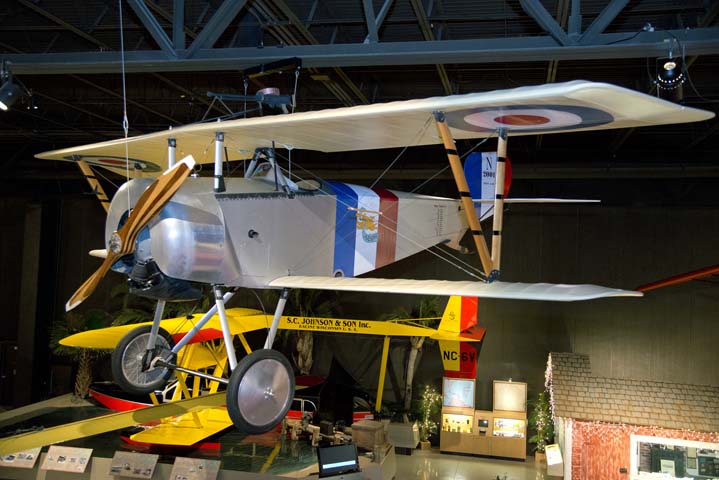Nieuport/Huntley 11 Replica - N2001
Location: Antiques & Classics
The Nieuport 11 was a single-place fighter, which, with its much larger upper wing is known as a sesquiplane. The dihedral of the single-spar lower wing could be ground adjusted up to 6 degrees to compensate for different engines and total weight. The upper wing carried the ailerons, had two spars and was placed ahead of the lower wing. There is no vertical stabilizer, just the large, distinctive rudder. The single axle landing gear was attached by V-struts and the tailskid was a steel spring.
Gustave Delage joined Nieuport as its design chief in 1914. His first design, the Nieuport 10, was a two-seat general reconnaissance aircraft, but performed well as a fighter when flown as a single-seater. This led Delage to design the similar but smaller Nieuport 11.
The 11 was known as the Bébé and as the “13 metre” Nieuport, a reference to its wing area. Design work began in 1915 and the first operational Nieuport 11 reached the front line in French service on January 5, 1916. While a difficult airplane to fly, the Nieuport 11, when operated by experienced pilots, enabled the French to regain air superiority over the German Fokker E.III.
The 11 played a vital role in controlling the skies over the Battles of Verdun and the Somme. Yet, so quick was the progress in aircraft design during the war, that by mid-1916, the Nieuport 11 was being replaced by its more powerful sibling, the Nieuport 16. Some were re-engined in the field with 110-hp Le Rhône engines and designated Nieuport 11Cs. Others were relegated to training units.
Like many World War I aircraft, the Nieuport 11 saw use by many different countries. They were operated by the air forces of France, Belgium, Colombia, Czechoslovakia, Italy, the Netherlands, Romania, Russia, Serbia, Ukraine, and Yugoslavia. The British Royal Flying Corps adopted the Nieuport 16 shortly after its introduction. After the war, two 11s went to Siam where they operated as trainers until 1933.
Armament was not state-of-the-art even for WWI standards due to the lack of an interrupter gear. The single machine gun mounted above the upper wing fired above the propeller arc. Its mount allowed it to be tipped back so the pilot could change the circular ammunition drum.
Engines used were 50-, 60-, or 80-hp Gnome or Le Rhône rotaries. They provided impressive maneuverability but that trait also made the aircraft difficult to fly. In use, the lower wing was known to fracture under stress with fatal results.
The only original Nieuport 11 known to exist is in the Musée de l’Air et de l’Espace in France, but numerous replicas of this WWI fighter have been built, including this full-scale static replica completed in 2003. It was built from scratch by its donor, Arthur Huntley, who was guided by plans for the Lou Proctor RC model and numerous vintage photographs.
Original Nieuport 11 Specs:
Length: 19 feet
Wingspan: 24 feet, 9 inches
Empty Weight: 759 pounds
Gross Weight: 1,213 pounds
Maximum Speed: 97 mph
Service Ceiling: 15,090 feet
Seats: 1
Powerplant: Gnome or Le Rhône rotary
Horsepower: 50-110 hp




